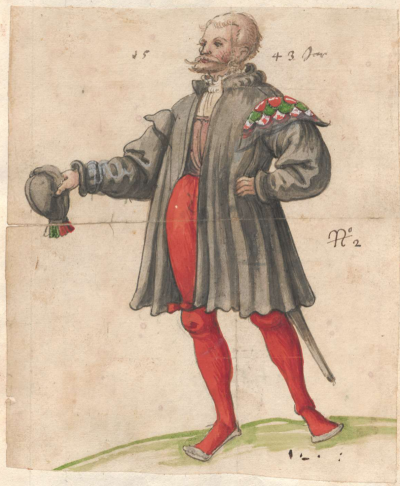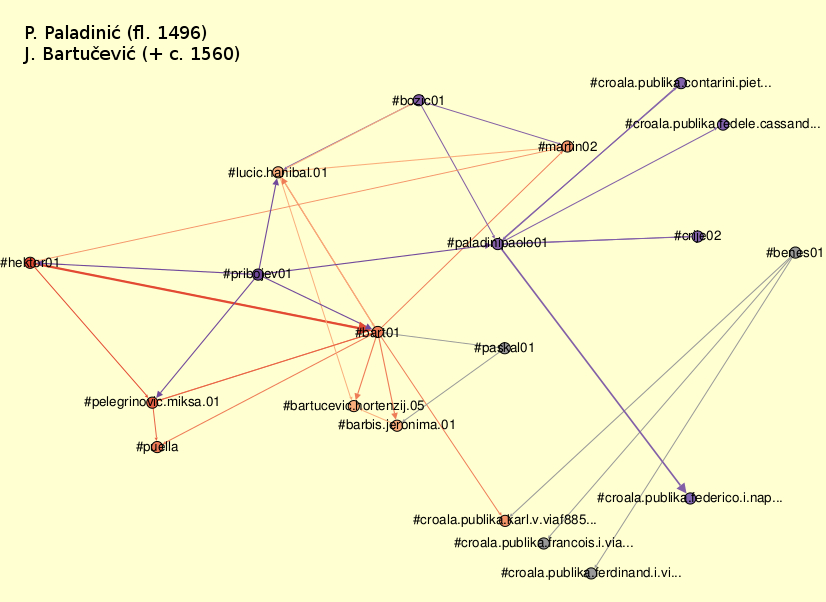Croatian humanists as a social group / Hrvatski humanisti kao društvena skupina
Neven Jovanović
A paper presented at the Colloquium Marulianum XXIV, Split, 22-24 April 2014.
Address of this page:
http://www.ffzg.unizg.hr/klafil/dokuwiki/doku.php/z:croat-tyrol-humsocgr.
Abstract
Renaissance humanism is a historical and a social phenomenon. It is usually defined as a specific cultural and educational movement. If that is the case, the members of the movement can be studied as a social group, as a number of individuals connected by common characteristics. What these characteristics are has in general been well defined and frequently convincingly settled in qualitative terms. We recognise the archetypes of the humanists, the exemplary and key members of the movement. What we do not know is the extent to which the characteristic features of humanism are to be found in a given community, in a specific space and time, particularly in areas outside the focal points of humanist activity such as Florence, Venice and Rome. The exact quantitative share of humanism, then, in a society like that of Renaissance Croatia, or, to narrow it even further down, in Dalmatia, is not well enough known. How many humanists were there in this society, in what ways were they similar to other members of the community, and in what respects did they differ? And can we at all answer these and similar questions, either with certainty or only speculatively?
My address will explain the points of departure for and the approach of such research, and will present preliminary findings on humanist characteristics and the degree to which they are featured in members of the intellectual élite of Dalmatia in the 1400–1600 period. The research is also a preparation for a more extensive comparison of Croatian and Tyrolean Latin literature within the framework of the scholarly project Croatica et Tyrolensia.
Material and illustrations
Triplici genere amititiae dum esset in humanis usus est. Primum genus est horum qui, licet abscentes et non noti, fama tamen nuncia incredibillem de laudatis operibus illius habuerunt opinionem; neque tamen optima spe, quam de eo conceperant, sunt destituti. (…) Secundum opptinuerunt locum uiri probi ac honorati, minus tamen docti, in numero quorum fuaerunt (…) Deinde secuntur uiri non mediocri doctrina insignes et in poetica facultate admodum pręstantęs, qui omnes dulcissimis alocutionibus disertissimisque carminibus uicisim et pręsentes se ad immortalitatis gloriam acuebant. Cognominantur hii (…)
F. Božićević, Vita Marci Maruli
Renaissance humanists seen as knots in an intellectual network. The network has a diachronic dimension (generations) and a synchronic one (supporters or competitors). What connects the humanists is their cultural capital: the symbols they know and share. In their contacts, whether physical or spiritual (e. g. through reading), humanists exchange emotional energy: what keeps them going:
what we mean by an intellectual group is just that its members assemble face-to-face often enough to build up intense exchanges of ritual interaction, forging idea-emblems, identities, emotional energies that persist and sometimes dominate others (…) Intensely focused situations penetrate the individual, forming symbols and emotions which are both the medium and the energy of individual thought and the capital which makes it possible to construct yet further situations in an ongoing chain.
Randall Collins, The Sociology of Philosophies (1998)
- Croatian humanists (and other neo-Latin authors) by generation: http://solr.ffzg.hr/basex/croalabib-aucsaec
- A list of Croatian humanists during 1400-1500: http://solr.ffzg.hr/basex/croalabib-aucsaecx?saecq=14xx
- A list of Croatian humanists during 1500-1600: http://solr.ffzg.hr/basex/croalabib-aucsaecx?saecq=15xx
- Number of Croatian humanists by city of origin or activity: http://solr.ffzg.hr/basex/croalabib-humgenpl
- c. 70 humanists attested as active during 1400-1500
- c. 100 humanists active 1500-1600
- at most 10 humanists active in a single city in a single 33-year period (a generation)
Demographic data for Croatia c. 1500: estimated population 928,000. Dalmatian cities (the largest are Zadar and Dubrovnik): not more than 6000–8000 inhabitants. Urban elites (political, economic, religious): up to 15% of a city's population (= 900 persons). Nine humanists active in a city (in Dubrovnik in the third third of 1500's) are less than 1% of its elite.


